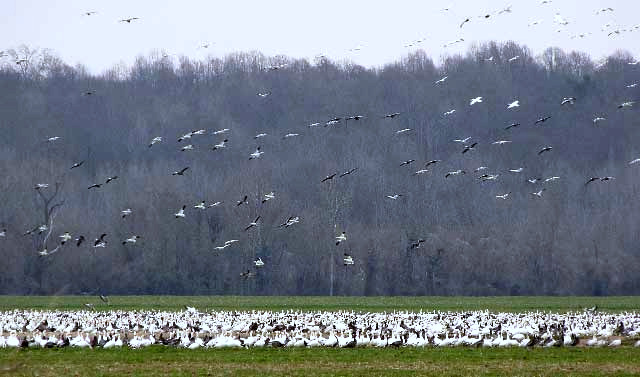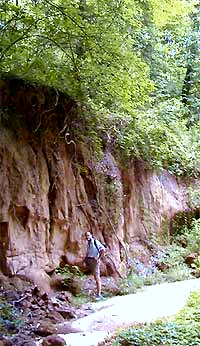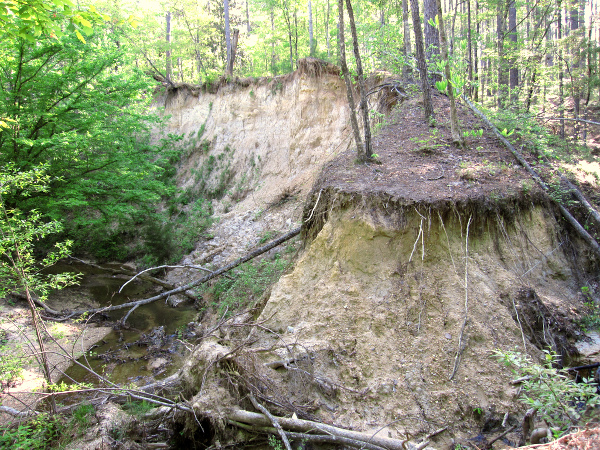
Ecology of Loess's
Steep-Walled Ravines, or Bayous

 The world inside the loess
zone's deep, steep-walled ravines, or bayous, looks, feels, and is different.
The world inside the loess
zone's deep, steep-walled ravines, or bayous, looks, feels, and is different.
As the picture at the right shows (that's Jim Conrad in a bayou on Laurel Hill Plantation just south of Natchez) much less sunlight enters into a deep ravine than outside it, because for much or all of the day the steep walls block the sunlight. Add to that trees at the walls' tops, vegetation leaning over the bayou at the cliff's edges, and shrubs and small trees clinging to the walls themselves, and you have a real sun screen.
Similarly, wind also has a hard time reaching deep into ravines. On an average summer day often leaves can be heard rustling among trees high above, outside the ravines, but, inside, there may be a dead calm, and a musty odor to boot.
Therefore, the interiors of our loess zone's steep-walled ravines, or bayous, are havens for moisture- and shade-loving plants and animals. These "ravine organisms" can be divided into two general groups:
Ferns are a good representative of the first kind. Various species may appear scattered across the forest floor outside the ravines, but several of the same species often grow much larger in robust colonies in the ravines' interiors. In fact, lush, green, cascading avalanches of frilly ferns are one of the most eye-catching features of loess-zone ravines.
 One kind of plant found in loess-zone ravines but seldom in the
uplands immediately beyond them is a kind of liverwort, pictured at the right. Liverworts
are primitive, spore-producing plants looking like flat, green ribbons about half an inch
wide forking again and again as the plant grows across the ravine's loess wall. Often
large portions of an otherwise bare but moist and shaded cliff will be covered with these
liverworts, providing a sight that nearly anyone would recognize as out of the ordinary.
One kind of plant found in loess-zone ravines but seldom in the
uplands immediately beyond them is a kind of liverwort, pictured at the right. Liverworts
are primitive, spore-producing plants looking like flat, green ribbons about half an inch
wide forking again and again as the plant grows across the ravine's loess wall. Often
large portions of an otherwise bare but moist and shaded cliff will be covered with these
liverworts, providing a sight that nearly anyone would recognize as out of the ordinary.
Inside the ravines it's easy to see the effects of fast-flowing water, for it's impossible to walk far without running into logjams in which large tree trunks have been maneuvered into surprising positions. When these powerful streams of fast-running water encounter a sharp turn at the base of a loess cliff, they often erode depressions below the cliff of considerable depth. These holes may retain water long after water in the ravine's streambed has disappeared. Therefore, especially during dry summers, loess-zone ravines, or bayous, often provide life-sustaining watering holes for wildlife.
In fact, by observing prints left behind by animals on the streambed, it's easy to gain the impression that loess-zone ravines are animal superhighways. Foremost among the tracks, as might be expected, are Whitetail Deer hoofprints, but also frequently observed are tracks of Coyote, Red Fox, and, at least in some areas, Wild Boar, which may root up large areas of streambeds. Of course there are smaller animals as well, such as the Armadillos who partly obliterate their prints as their heavy tails drag behind, Raccoons whose front paws leave prints like little human hands, Opossums with their backward-pointing "thumbs," and even the occasional Eastern Gray Squirrel which come down from the trees, leaving marks in the mud showing their long, needle-like nails. During certain times of the year it's not uncommon to be distracted from one's bayou-wandering by sprays of dirt being ejected from beneath the roots of a tree clinging to the slope's wall. Here a Chipmunk is busy excavating its tunnels.
Local folk often avoid walking in loess-zone ravines for fear of snakes. In the author's experience, snakes, particularly poisonous species, are less common in ravines than outside them. Nonetheless, one should always follow two main snake-avoiding rules: